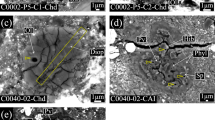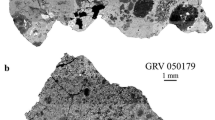Abstract
Numerous round to oblate opaque assemblages (OAs) are found in chondrules and matrix of the Ningqiang carbonaceous chondrite. They are mainly composed of Ni-rich metal, magnetite, Fe, Ni-sulfides, with minor amounts of phosphate, phosphoran-olivine, pyroxene and trace amounts of nano-sized platinum-group metal alloys. The mineralogy of Ningqiang OAs is very similar to that of OAs previously reported in Ca, Al-rich inclusions of CV chondrites. Being a rare mineral phase in nature, phosphoran-olivine is thought to form by nonequilibrium reactions between P-bearing molten metal and olivine crystals during rapid cooling. Its occurrence in Ningqiang OAs indicates that the precursor of OAs was locally produced during chondrule formation, rather than directly condensed from the solar nebula as previously thought. The petrographic and mineralogical characteristics of Ningqiang OAs reveal that OAs formed by low temperature alterations of pre-existing homogeneous alloys within chondrules on a planetary body.
Similar content being viewed by others
References
Grossman L. Refractory inclusions in the Allende meteorite. Annu Rev Earth Planet Sci, 1980, 8: 559–608
Palme H, Hutcheon I D, Spettel B. Composition and origin of refractory-metal-rich assemblage in a Ca-Al-rich Allende inclusion. Geochim Cosmochim Acta, 1994, 58: 495–513
E1 Goresy A, Nagel K, Ramdohr P. Fremdlinge and their noble relatives. Proc Lunar Planet Sci, 1978, 9: 1279–1303
Wark D A, Lovering J F. Refractory/platinum metal grains in Allende calcium-aluminum-rich clasts (CARC’s): possible exotic presolar material? Lunar Planet Sci, 1976, VII: 912–914
Haggerty S E, McMahon B M. Magnetite-sulfide-metal complexes in the Allende meteorite. Proc Lunar Planet Sci, 1979, 10: 851–870
Armstrong J T, El Goresy A, Wasserburg G J. Willy: a prize noble Ur-Fremdling—its history and implications for the formation of Fremdlinge and CAI. Geochim Cosmochim Acta, 1985, 49: 1001–1022
Armstrong J T, Hutcheon I D, Wasserburg G J. Zelda and Company: petrogenesis of sulfide-rich Fremdlinge and constraints on solar nebula processes. Geochim Cosmochim Acta, 1987, 51: 3155–3173
Blum J D, Wasserburg G J, Hutcheon I D, et al. ’Domestic’ origin of opaque assemblages in refractory inclusions in meteorites. Nature, 1988, 331: 405–409
Blum J D, Wasserburg G J, Hutcheon I D, et al. Origin of opaque assemblages in C3V meteorites: implications for nebular and planetary processes. Geochim Cosmochim Acta, 1989, 53: 543–556
Zinner E K, Caillet C, El Goresy A. Evidence for extraneous origin of a magnesiowüstite-metal Fremdlinge from the Vigarano CV3 chondrite. Earth Planet Sci Lett, 1991, 102: 252–264
Hsu W, Guan Y, Hua X, et al. Aqueous alteration of opaque assemblages in the Ningqiang carbonaceous chondrite: evidence from oxygen isotopes. Earth Planet Sci Lett, 2006, 243: 107–114
Choi B G, Wasson J T. Microscale oxygen isotopic exchange and magnetite formation in the Ningqiang anomalous carbonaceous chondrites. Geochim Cosmochim Acta, 2003, 67: 4655–4660
McMahon B M, Haggerty S E. Experimental studies bearing on the magnetite-alloy-sulfide association in the Allende meteorite: constraints on the conditions of chondrule formation. Proc Lunar Planet Sci, 1980, 11: 1003–1025
Bischoff A, Palme H. Composition and mineralogy of refractory-metal-rich assemblages from a Ca, Al-rich inclusion in the Allende meteorite. Geochim Cosmochim Acta, 1987, 51: 2733–2748
Hsu W, Huss G R, Wasserburg G J. Al-Mg systematics of CAIs, POI, and ferromagnesian chondrules from Ningqiang. Meteorit Planet Sci, 2003, 38: 35–48
Buseck P R. Pallasite meteorites—mineralogy, petrology and geochemistry. Geochim Cosmochim Acta, 1977, 41: 711–740
Buseck P R, Clark J. Zaisho—a pallasite containing pyroxene and phosphoran olivine. Mineral Mag, 1984, 48: 229–235
Goodrich C A. Phosphoran pyroxene and olivine in silicate inclusions in natural iron-carbon alloy, Disko Island, Greenland. Geochim Cosmochim Acta, 1984, 48: 1115–1126
Agrell S O, Charnley N R, Chinner G A. Phosphoran olivine from Pine Canyon, Piute Co., Utah Mineral Mag, 1998, 62: 265–269
Tropper P, Recheis A, Konzett J. Pyrometamorphic formation of phosphorus-rich olivines in partially molten metapelitics gneisses from a prehistoric sacrificial burning site (Ötz Valley, Tyrol, Austria). Eur J Mineral, 2004, 16: 631–640
Boesenberg J S, Ebel D S, Hewins R H. An experimental study of phosphoran olivine and its significance in main group pallasites. Lunar Planet Sci, 2004, XXXV: 1366–1367
Kracher A. Notes on the evolution of the IIIAB/pallasite parent body. Lunar Planet Sci, 1983, XIV: 405–406
Anderson A T, Greenland L P. Phosphorus fractionation diagram as a quantitative indicator of crystallization differentiation of basaltic liquids. Geochim Cosmochim Acta, 1969, 33: 493–505
Newsom H E, Drake M J. Experimental investigation of the partitioning of phosphorus between metal and silicate phases: implications for the Earth, Moon and Eucrite parent body. Geochim Cosmochim Acta, 1983, 47: 93–100
Stolper E, Paque J M. Crystallization sequences of Ca-Al-rich inclusions from Allende: the effects of cooling rate and maximum temperature. Geochim Cosmochim Acta, 1986, 50: 1785–1806
Lofgren G E. A dynamic crystallization model for chondrule melts. In: Hewins R E, Jones R H, Scott E R D, eds. Chondrules and the Protoplanetary Disk. Cambridge: Cambridge University Press, 1996. 187–196
Campbell A J, Simon S B, Humayun M, et al. Chemical evolution of metal in refractory inclusions in CV3 chondrites. Geochim Cosmochim Acta, 2002, 67: 3119–3134
Clayton R N, Kieffer S W. Oxygen isotopic thermometer calibrations. In: Taylor H P J, O’Neil J R, Kaplan I R, eds. Stable Isotope Geochemistry: A Tribute to Samuel Epstein. San Antonio: Lancaster Press, 1991. 3–10
Zolensky M, McSween H Y. Aqueous alteration. In: Kerridge J F, Matthews M S, eds. Meteorites and the Early Solar System. Tucson, AZ: University of Arizona Press, 1988. 114–143
Krot A N, Scott E D, Zolensky M E. Mineralogical and chemical modification of components in CV3 chondrites: nebular or asteroidal processing? Meteoritics, 1995, 30: 748–775
Lauretta D S, Lodders K, Fegley B Jr. Experimental simulations of sulfide formation in the solar nebular. Science, 1997, 277: 358–360
Travis B J, Schubert G. Hydrothermal convection in carbonaceous chondrite parent bodies. Earth Planet Sci Lett, 2005, 240: 234–250
Rubin A E, Wasson J T. Chondrules, matrix and coarse-grained chondrule rims in the Allende meteorite: origin, interrelationships and possible precursor components. Geochim Cosmochim Acta, 1987, 51: 1923–1937
Author information
Authors and Affiliations
Corresponding author
Additional information
Supported by the Chinese National Natural Science Foundation for Distinguished Young Scholars (Grant No. 40325009), the One-Hundred-Talent Program of Chinese Academy of Sciences, and the Minor Planet Foundation of China
Rights and permissions
About this article
Cite this article
Wang, Y., Hua, X. & HSU, W. Petrogenesis of opaque assemblages in the Ningqiang carbonaceous chondrite. SCI CHINA SER D 50, 886–896 (2007). https://doi.org/10.1007/s11430-007-0006-z
Received:
Accepted:
Issue Date:
DOI: https://doi.org/10.1007/s11430-007-0006-z




